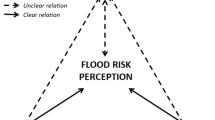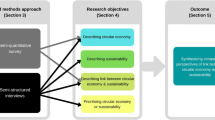Abstract
Despite growing knowledge of a disparity between stated and actual willingness to engage in pro-environmental behavior, little is known about the cognitive or attitudinal factors explaining the disparity. In the context of water quality improvement in a river basin, we address the disparity issue by applying two approaches: a typical valuation question with a hypothetical option of voluntary payment and a valuation question with a real option of voluntary payment. The latter treatment allows for further analysis of the respondents who committed to a real payment. We show empirical evidence on the psychological factors explaining the disparity between the treatments and its relationship with response uncertainty. The extent of learning from the survey about water management of the watershed increased the likelihood of stating the willingness to contribute, either with certainty or uncertainty. In turn, a previous contribution to the environmental issue, higher income, belief in the scenario, and responding to the hypothetical treatment increased the likelihood of stating certain willingness to contribute. Our findings indicate that the factors influencing the decision on the maximum payment differ between treatments. Cognitive factors, such as perceiving the valuation scenario as plausible, learning from the questionnaire, and in which mailing round the respondent completed the survey, only explained the stated amount for the willingness to pay in the treatment with a hypothetical option for voluntary payment. In the real option treatment, a higher stated willingness to pay was more likely if the respondent actually made the payment and had a higher household income.

Similar content being viewed by others
Notes
With the objective to achieve a good ecological and chemical status to protect human health, the water supply, natural ecosystems, and biodiversity.
See, for example, the opinion of the famous blue-ribbon panel - assembled by NOAA- who assessed the reliability of CV methods (Arrow et al. 1993).
However, not every yes response revealed actual payment, and there were also actual payers among the “yes, possibly” responses.
References
Akter S, Brouwer R, Brander L, van Beukering P (2009) Respondent uncertainty in a contingent market for carbon offsets. Ecol Econ 68:1858–1863. doi:10.1016/j.ecolecon.2008.12.013
Alberini A, Kahn JR (2006) Handbook on contingent valuation. Edward Elgar Publishing Inc., Massachusetts
Arrow K, Solow R, Portney PR, Leamer EE, Radner R, Schuman H (1993) Report of the NOAA panel on contingent valuation. National Oceanic and Atmospheric Administration. Federal Register 58(10):4601–4614
Bishop MM, Barber NA (2014) Putting your money where your mouth is: the value of low purchase intention consumers to product Pricing. J Prod Innovat Manag 31:908–923. doi:10.1111/jpim.12131
Blomquist GC, Blumenschein K, Johannesson M (2009) Eliciting willingness to pay without bias using follow-up certainty statements: comparisons between probably/definitely and a 10-point certainty scale. Environmental & Resource Economics 43:473–502. doi:10.1007/s10640-008-9242-8
Blumenschein K, Johannesson M, Blomquist GC, Liljas B, OConor RM (1997) Hypothetical versus real payments in Vickrey auctions. Econ Lett 56:177–180. doi:10.1016/S0165-1765(97)81897-6
Brouwer R (2011) A mixed approach to payment certainty calibration in discrete choice welfare estimation. Appl Econ 43:2129–2142. doi:10.1080/00036840903035977
Brown TC, Champ PA, Bishop RC, McCollum DW (1996) Which response format reveals the truth about donations to a public good? Land Econ 72:152–166. doi:10.2307/3146963
Byrnes B, Jones C, Goodman S (1999) Contingent valuation and real economic commitments: evidence from electric utility green Pricing Programmes. J Environ Plan Manag 42:149–166. doi:10.1080/09640569911190
Carson RT, Groves T (2007) Incentive and informational properties of preference questions. Environmental & Resource Economics 37:181–210. doi:10.1007/s10640-007-9124-5
Champ PA, Bishop RC (2001) Donation payment mechanisms and contingent valuation: an empirical study of hypothetical bias. Environmental & Resource Economics 19:383–402. doi:10.1023/A:1011604818385
Dillman D A. (2007) Mail and internet surveys. The tailored design method. second edn. John Wiley & Sons, Inc., New Jersey
Duffield JW, Patterson DA (1992) Field Testing existence values: comparison of hypothetical and cash transaction values. In: Rettig RB (ed) Benefits and costs in natural resource planning. Fifth Interim Report
European Parliament CotEU (2000) Water framework directive, 2000. European Parliament and of the Council
Foster V, Bateman IJ, Harley D (1997) Real and hypothetical willingness to pay for environmental preservation: a non-experimental comparison. J Agric Econ 48:123–138. doi:10.1111/j.1477-9552.1997.tb01140.x
Frykblom P (1997) Hypothetical question modes and real willingness to pay. J Environ Econ Manag 34:275–287. doi:10.1006/jeem.1997.1015
Gollwitzer PM (1993) Goal achievement: the role of intentions. In: Stroebe W, Hewstone M (eds) European review of social psychology, vol 4. Wiley, Chichester, pp 141–185
Gujarati DN (2004) Basic Econometrics. Fourth edn. The McGraw−Hill 10.1007/s11269-017-1733-3 Companies, ISBN 9780070597938, p 1002
Hakansson C (2008) A new valuation question: analysis of and insights from interval open-ended data in contingent valuation. Environ Resour Econ 39:175–188. doi:10.1007/s10640-007-9102-y
Hanley N, Kristrom B, Shogren JF (2009) Coherent arbitrariness: on value uncertainty for environmental goods. Land Econ 85:41–50
Kling CL, Phaneuf DJ, Zhao JH (2012) From Exxon to BP: has some number become better than no number? J Econ Perspect 26:3–26. doi:10.1257/jep.26.4.3
List JA, Gallet CA (2001) What experimental protocol influence disparities between actual and hypothetical stated values? Environ Resour Econ 20:241–254. doi:10.1023/A:1012791822804
Little J, Berrens R (2004) Explaining disparities between actual and hypothetical stated values: further investigation using meta−analysis. Econ Bull 3:1–13
Loomis J, Ekstrand E (1998) Alternative approaches for incorporating respondent uncertainty when estimating willingness to pay: the case of the Mexican spotted owl. Ecol Econ 27:29–41. doi:10.1016/S0921-8009(97)00126-2
Loomis J, Brown T, Lucero B, Peterson G (1996) Improving validity experiments of contingent valuation methods: results of efforts to reduce the disparity of hypothetical and actual willingness to pay. Land Econ 72:450–461. doi:10.2307/3146908
Macmillan DC, Smart TS, Thorburn AP (1999) A field experiment involving cash and hypothetical charitable donations. Environ Resour Econ 14:399–412. doi:10.1023/A:1008304405734
Mitchell RC, Carson RT (1993) Using Surveys to value public goods: the contingent valuation method. Third edn. Resources for the Future, 1616 P street, N.W., Washington, D.C. 20036
Moser R, Raffaelli R, Notaro S (2014) Testing hypothetical bias with a real choice experiment using respondents' own money. Eur rev Agric Econ 41:25–46. doi:10.1093/erae/jbt016
Murphy JJ, Stevens TH (2004) Contingent valuation, hypothetical bias, and experimental Economics. Agric ResourEcon Rev 33:182–192
Murphy JJ, Allen PG, Stevens TH, Weatherhead D (2005) A meta-analysis of hypothetical bias in stated preference valuation. Environ Resour Econ 30:313–325. doi:10.1007/s10640-004-3332-z
Navrud S (1992) Willingness to pay for preservation of species: an experiment with actual payments. In: Navrud S (ed) Pricing the European Environment. Oxford University Press, New York, pp 231–246
Neill HR, Cummings RG, Ganderton PT, Harrison GW, Mcguckin T (1994) Hypothetical Surveys and real economic commitments. Land Econ 70:145–154. doi:10.2307/3146318
Newell LW, Swallow SK (2013) Real-payment choice experiments: valuing forested wetlands and spatial attributes within a landscape context. Ecol Econ 92:37–47. doi:10.1016/j.ecolecon.2012.08.008
Poe GL, Vossler CA (2002) Monte Carlo benchmarks for discrete response valuation methods: comment. Land Econ 78:605–616. doi:10.2307/3146856
Ready RC, Champ PA, Lawton JL (2010) Using respondent uncertainty to mitigate hypothetical bias in a stated choice experiment. Land Econ 86:363–381
Schlapfer F, Fischhoff B (2012) Task familiarity and contextual cues predict hypothetical bias in a meta-analysis of stated preference studies. Ecol Econ 81:44–47. doi:10.1016/j.ecolecon.2012.06.016
Spencer MA, Swallow SK, Miller CJ (1998) Valuing water quality monitoring: a contingent valuation experiment involving hypothetical and real payments. Agric Resour Econ Rev 27:28–42
Svedsater H (2007) Ambivalent statements in contingent valuation studies: inclusive response formats and giving respondents time to think. Aust J Agr Resour Ec 51:91–107. doi:10.1111/j.1467-8489.2007.00346.x
Voltaire L, Pirrone C, Bailly D (2013) Dealing with preference uncertainty in contingent willingness to pay for a nature protection program: a new approach. Ecol Econ 88:76–85. doi:10.1016/j.ecolecon.2013.01.009
Vossler CA, Watson SB (2013) Understanding the consequences of consequentiality: Testing the validity of stated preferences in the field. J Econ Behav Organ 86:137–147. doi:10.1016/j.jebo.2012.12.007
Vossler CA, Doyon M, Rondeau D (2012) Truth in consequentiality: theory and field evidence on discrete choice experiments. Am Econ J-Microecon 4:145–171. doi:10.1257/mic.4.4.145
Author information
Authors and Affiliations
Corresponding author
Appendices
Appendix 1
Appendix 2. Questionnaire to those who expressed willingness to pay, but who did not pay
-
1.
I didn’t pay because
(Choose the most suitable alternative and mark it with 1, and the second best alternative with 2):
[] I changed my mind about paying.
[] I couldn’t afford to pay.
[] I forgot.
[] I wanted to consider the matter further.
[] I felt that I didn’t support this project enough to pay for it.
[] I preferred voluntary work to donation.
[] Some other reason, what? __________________________
Rights and permissions
About this article
Cite this article
Lehtoranta, V., Kosenius, AK. & Seppälä, E. Watershed Management Benefits in a Hypothetical, Real Intention and Real Willingness to Pay Approach. Water Resour Manage 31, 4117–4132 (2017). https://doi.org/10.1007/s11269-017-1733-3
Received:
Accepted:
Published:
Issue Date:
DOI: https://doi.org/10.1007/s11269-017-1733-3




